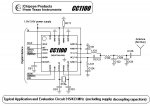I think we can assume they are made where English isn't the first language

Hence price.
However, with amusement, I must say that comments on spelling mistakes from this Forum reminds me of pots and kettles. I include myself....
Drac, I think saying -88dB is a little deaf is a little unfair as it is
data-rate related, so maybe don't write it off.
It isn't designed to provide Moon-Earth transmission.
Phrases like Data In - RF out etc. are probably simple little phrases to catch the eye of the hobbyist.
Any RF Module designer designing 'Nothing In' and something out would need shooting

(I assume that is your implication?)
After all, all the cheapo (and not-so-cheapo) basic AM/FM modules are dataIn-RFOut and vice-versa.
But I agree, the Data Sheets are pathetic.
I can't speak for the 2400 version but the second one using the CC1100 needs some thought by the user.
It
isn't a simple Data In - RF Out -- unless there is a uP on board which I doubt.
That chip does packetisation etc. and it is up to the user (you) to set the parameters by setting registers using SPI.
After the wrestling that I had with a similar product from Microchip (where I was trying, and failing, to include a Maxstream header) I would
strongly suggest that this isn't suitable for the novice, as , essentially, your code will have to do much of what devices like XBee do for you.
Check the chipset if you don't believe me.
So, for things like XBee someone else has written the fiddly code, and hence the extra cost.
If it wasn't for the cost, the first item would be of interest.
Whilst I like XBee, it is OTT for functionality (for me as I'm not interested in ZigBee) and slow to set up via serial.
I would prefer to build my own packets, but there are big advantages with devices like CC1100 doing it all and CRC by hardware.
And being able to set regiters via SPI is much faster and moe convenient.
If I can get a 30% off voucher I might buy one.
I had looked at the CC1100 and CC1101 before but couldn't be bothered because of the PCB. But now someone is doing it I may revisit.
I would imagine the 2400 is easy and the CC1100 is fiddly. Just depends on your experience and patience.

